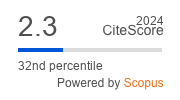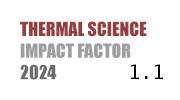ABSTRACT
The benefit of the graphene coating is twofold. Firstly, the lower temperature on the graphene coated pin fin can be attained, thus ensuring the application system to operate at lower temperatures, preventing overheating. Secondly, the graphene coated fin could yield more uniform distribution of temperature along the pin fin, thereby producing a more uniform heat dissipation along the fin. With such a coating, an improved cooling system can be created, in alleviating the heat transfer limit of conventional heat sink. Numerical results reported in this study revealed that the graphene coating is consistently beneficial for heat dissipation for all cases investigated, regardless of the air velocity, coating thickness, and pin fin length. At the longest pin fin examined, which is 25 D, the temperature difference between the base and the tip of the pin fin can be reduced to 1.70 K, as compared to 10.60 K temperature difference for the conventional pin fin. Additionally, thermal resistance reduction of up to 56.60 % can be attained using the graphene coating technique.
KEYWORDS
PAPER SUBMITTED: 2024-11-11
PAPER REVISED: 2025-02-15
PAPER ACCEPTED: 2025-04-30
PUBLISHED ONLINE: 2025-07-05
- Gan, J. S., Hung, Y. M., Remarkable thermal performance enhancement of micro heat pipes with graphene-nanoplatelet nano-wicks, Nanomaterials, 13 (2023), 2, 232
- Balandin, A. A., et al., Superior thermal conductivity of single-layer graphene, Nano Letters, 8(2008), 3, pp. 902-907
- Ghosh, S., Sharma, M., Electron optics with magnetic vector potential barriers in graphene,Journal of Physics: Condensed Matter, 21 (2009), 29, 292204
- Seol, J. H., et al., Two-dimensional phonon transport in supported graphene, Science, 328 (2010),5975, pp. 213-216
- Yu, Z., et al., Highly thermal conductive epoxy composites enabled by 3D graphene/Cu-baseddual networks for efficient thermal management, Composites Communications, 46 (2024), 101845
- Wu, R., et al., Filling the gap: thermal properties and device applications of graphene, ScienceChina Information Sciences, 64 (2021), pp. 1-17
- Amirpour, S., et al., Highly thermal conductive graphene-based heatsink tailored for electricpropulsion SiC-based inverter, Applied Thermal Engineering, 243 (2024), 122548
- Cheng, C., et al., Evaluation of surfactants on graphene dispersion and thermal performance forheat dissipation coating, Polymers, 14 (2022), 5, 952
- Lv, L., et al., Graphene-based thermal interface materials: an application-oriented perspective onarchitecture design, Polymers, 10 (2018), 11, 1201
- Hu, J., et al., Significant enhancement of metal heat dissipation from mechanically exfoliatedgraphene nanosheets through thermal radiation effect, AIP Advances, 7, (2017), 5
- Cheng, S., et al., Co-enhancement of thermal conduction and radiation through morphologiescontrolling of graphene functional layer for chip thermal management, Nano Research, 17 (2024),10, pp. 8885-8892
- Kung, F., Yang, M.-C., Improvement of the heat-dissipating performance of powder coating withgraphene, Polymers, 12 (2020), 6, 1321
- Fang, J., et al., Thermal management of a semiconductor laser array based on a graphite heatsink, Applied Optics, 58 (2019), 28, pp. 7708-7715
- Praveen, B., et al., Heat transfer performance of graphene nano-platelets laden microencapsulatedPCM with polymer shell for thermal energy storage based heat sink, AppliedThermal Engineering, 156 (2019), pp. 237-249
- Lv, S., et al., The passive cooling and thermal properties of the dual functional film composed ofgraphene and PDMS-TiO2: application in the passive heat sink, Solar Energy Materials and SolarCells, 276 (2024), 113077
- Dai, W., et al., Ultralow interfacial thermal resistance of graphene thermal interface materialswith surface metal liquefaction, Nano-Micro Letters, 15 (2022), 1, 9
- Chen, L., et al., Effect of graphene coating on the heat transfer performance of a composite anti-/deicing component, Coatings, 7 (2017), 10, 158
- Wang, J.-X., et al., Nano-enhanced graphite/phase change material/graphene composite forsustainable and efficient passive thermal management, Advanced Science, 11 (2024), 38, 2402190
- Teng, T.-P., et al., Enhanced heat dissipation performance of automotive LED lamps usinggraphene coatings, Polymers, 14 (2022), 1, 50
- Pradhan, S. K., et al., Graphene-incorporated aluminum with enhanced thermal and mechanicalproperties for solar heat collectors, AIP Advances, 10 (2020), 065016
- Choong, J.Y., et al., Numerical assessment on heat transfer performance of double-layeredoblique fins micro-channel heat sink with Al2O3 nanofluid, Thermal Science, 26 (2022), No. 1Bpp. 477-488
- Soo, Y. H., et al., Heat transfer enhancement of staggered water-droplet grooved microchannelheat sink using Al2O3 nanofluid, Thermal Science, 28 (2024), No. 3B pp. 2477-2490
- Shkarah, A. J., et al., A 3D numerical study of heat transfer in a single-phase micro-channel heatsink using graphene, aluminum and silicon as substrates, International Communications in Heatand Mass Transfer, 48 (2013), pp. 108-115
- Mann, S., et al., Thermodynamic properties of pure and doped (B, N) graphene, RSC Advances, 6(2016), 15, pp. 12158-12168
- Ghajar, A. J.,Yunus, A., Cengel, D., Heat and Mass Transfer: Fundamentals and Applications.McGraw-Hill Education, 2014
- Abdelmohimen, M. A., et al., Numerical investigation of using different arrangement of fin slideson the plate-fin heat sink performance, Thermal Science, 25 (2021), No. 6B, pp. 4683-4693
- Roy, R., Kundu, B., Effects of fin shapes on heat transfer in microchannel heat sinks, HeatTransfer—Asian Research, 47 (2018), 4, pp. 646-659
- Xie, G., et al., Analysis of micro-channel heat sinks with rectangular-shaped flow obstructions,Numerical Heat Transfer, Part A: Applications, 69 (2016), 4, pp. 335-351

